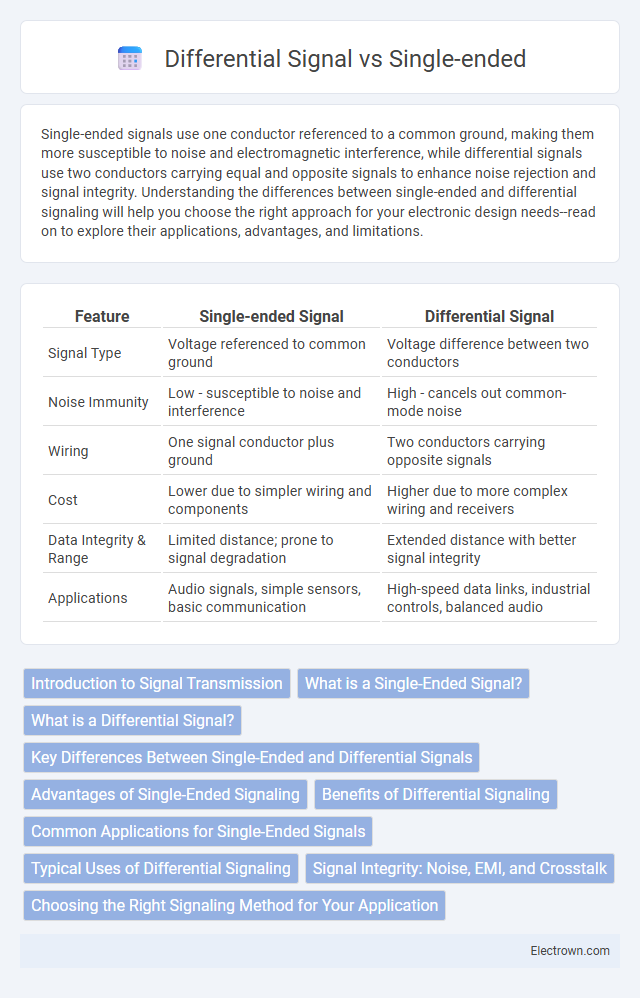Single-ended signals use one conductor referenced to a common ground, making them more susceptible to noise and electromagnetic interference, while differential signals use two conductors carrying equal and opposite signals to enhance noise rejection and signal integrity. Understanding the differences between single-ended and differential signaling will help you choose the right approach for your electronic design needs--read on to explore their applications, advantages, and limitations.
Table of Comparison
| Feature | Single-ended Signal | Differential Signal |
|---|---|---|
| Signal Type | Voltage referenced to common ground | Voltage difference between two conductors |
| Noise Immunity | Low - susceptible to noise and interference | High - cancels out common-mode noise |
| Wiring | One signal conductor plus ground | Two conductors carrying opposite signals |
| Cost | Lower due to simpler wiring and components | Higher due to more complex wiring and receivers |
| Data Integrity & Range | Limited distance; prone to signal degradation | Extended distance with better signal integrity |
| Applications | Audio signals, simple sensors, basic communication | High-speed data links, industrial controls, balanced audio |
Introduction to Signal Transmission
Signal transmission involves conveying electrical signals between devices, where single-ended signals use one conductor referenced to a common ground, making them simpler but more susceptible to noise. Differential signals employ two conductors carrying opposite voltages, enhancing noise immunity and signal integrity, especially in electrically noisy environments. Your choice between single-ended and differential signaling depends on the required noise resistance, transmission distance, and data integrity for your application.
What is a Single-Ended Signal?
A single-ended signal uses one conductor to carry the voltage signal relative to a common ground reference, making it simpler and more cost-effective for short-distance communication. This type of signal is susceptible to noise and interference because any unwanted voltage on the ground line directly affects signal integrity. Common examples include traditional analog audio signals and basic digital logic signals in microcontroller circuits.
What is a Differential Signal?
A differential signal transmits data using two complementary voltage lines, which enhances noise immunity and signal integrity by allowing the receiver to measure the voltage difference between the lines. Unlike single-ended signals that reference a common ground, differential signaling reduces electromagnetic interference (EMI) and crosstalk, making it ideal for high-speed and long-distance communication. Choosing differential signals for your designs can significantly improve performance in environments with electrical noise.
Key Differences Between Single-Ended and Differential Signals
Single-ended signals use one conductor and a common ground, making them more susceptible to noise and interference in your data transmission. Differential signals transmit two complementary signals through paired conductors, which improves noise immunity and signal integrity by allowing the receiver to detect the difference between the pairs. Choosing between single-ended and differential signaling depends on factors like noise environment, data rate, and cable length, with differential signaling preferred for high-speed or long-distance applications.
Advantages of Single-Ended Signaling
Single-ended signaling offers simplicity and cost-effectiveness by requiring fewer conductors, which reduces wiring complexity and material expenses. It is well-suited for short-distance communication where electromagnetic interference (EMI) is minimal, allowing reliable data transmission without the need for complex circuitry. Your system can benefit from easier implementation and lower power consumption when using single-ended signals in appropriate environments.
Benefits of Differential Signaling
Differential signaling offers superior noise immunity by transmitting two complementary signals, allowing common-mode noise to be canceled out effectively. It enhances signal integrity over long distances and high frequencies, reducing electromagnetic interference (EMI) and crosstalk compared to single-ended signals. This method also provides improved data reliability and higher transmission speeds in critical applications such as telecommunications, data communication, and high-speed digital circuits.
Common Applications for Single-Ended Signals
Single-ended signals are commonly used in audio equipment, consumer electronics, and simple communication interfaces where cost efficiency and simplicity are priorities. These signals transmit data through a single conductor with a common ground, making them suitable for short-distance connections like headphone jacks and analog microphones. Your devices often rely on single-ended signaling for straightforward implementation in less noise-sensitive environments.
Typical Uses of Differential Signaling
Differential signaling is typically used in high-speed data communication systems such as USB, Ethernet, and HDMI due to its superior noise immunity and reduced electromagnetic interference. These signals transmit data over two wires with opposite polarities, allowing receivers to detect signals accurately even in electrically noisy environments. Your choice of differential signaling enhances signal integrity in applications requiring long cable runs or environments with significant electrical noise.
Signal Integrity: Noise, EMI, and Crosstalk
Single-ended signals are more susceptible to noise, electromagnetic interference (EMI), and crosstalk due to their reliance on a single conductor referenced to ground, which can degrade signal integrity. Differential signals use two complementary conductors, providing inherent noise rejection and improved resistance to EMI, resulting in higher signal integrity in noisy environments. Ensuring your design utilizes differential signaling where noise immunity is critical will significantly enhance overall system performance and reliability.
Choosing the Right Signaling Method for Your Application
Single-ended signaling uses one reference line, making it cost-effective but more susceptible to noise and interference, ideal for short-distance or low-frequency applications. Differential signaling transmits two complementary signals, offering superior noise rejection and signal integrity, essential for high-speed or long-distance communication. Selecting the right method depends on factors such as signal speed, transmission distance, electromagnetic interference environment, and system complexity.
Single-ended vs Differential Signal Infographic

 electrown.com
electrown.com